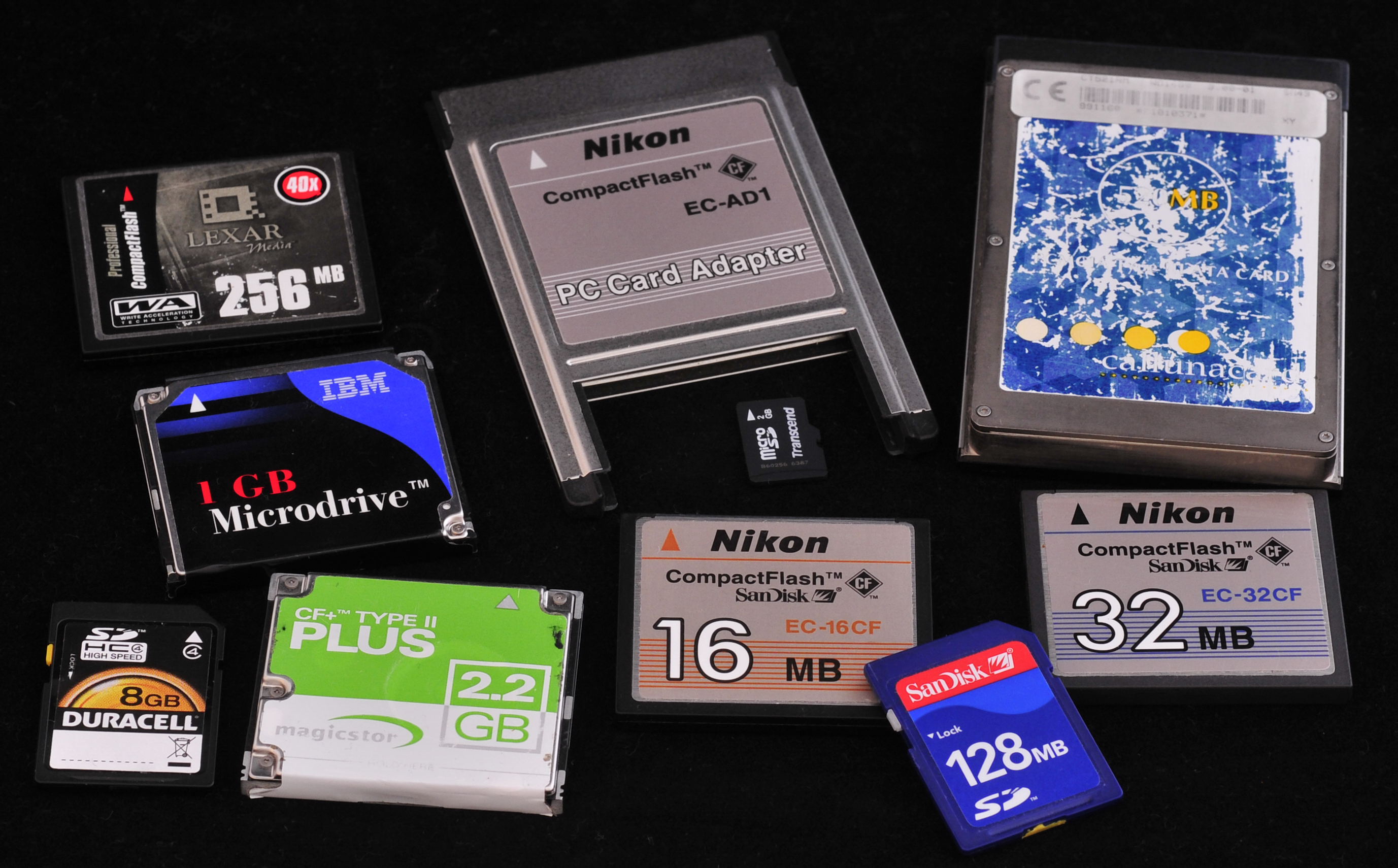All about memory cards.
CW: CF-card, PC card adapter for PCMCIA slot; PCMCIA card; CF card; SD card; CF card; microdrive (Magicstar); SD card; microdrive (IBM), in the center a mini SD card. Since the advent of the digital camera images have to be stored on a memory device. The very first Nikon Coolpix 100 and Coolpix 300 and some newer Coolpix cameras (e.g. Nikon Coolpix S01) have an internal memory device. All other digital cameras are using an external memory card.
More recently are the Compact Flash and Secure Digital memory cards.
Dimensions: 43×36×3.3 mm (Type I); 43×36×5 mm (Type II); Weight 10 gram (typical). XQD card, introduced in 2013, is the offcical successor of the CF card. It is a bit larger (38.5 x 29.8 mm) than a SD-card (see hereafter) and has a top speed of 125 Mbytes- 500 Mbytes per second. Secure Digital (SD) is a non-volatile memory card format developed by the SD Card Association (SDA) for use in portable devices. The standard was introduced in August 1999 as an improvement over MultiMediaCards (MMC), and has become the de facto industry standard. Secure Digital includes four card families available in three different form factors. The four families are the original Standard-Capacity (SDSC), the High-Capacity (SDHC), the eXtended-Capacity (SDXC), the Ultra Capacity (SDUC) and the SDIO, which combines input/output functions with data storage. The three form factors are the original size, the mini size, and the micro size. Electrically passive adapters allow a smaller card to fit and function in a device built for a larger card.
Mini: 21.5×20.0×1.4 mm; Weight Mini: ~0.8 g Micro: 15.0×11.0×1.0
mm; Weight Micro: ~0.25 g
Card capacity & speedThe maximum storage capacity of a memory card depends on what camera you are using. The very first digital compact cameras did not need huge capacity cards as the total number of bytes per image were not that large. But modern digital cameras with large sensors can produce up to 100 Mb. images. If you use an older digital camera producing low Mb. images a memory card with a low capacity (4 - 32Mb) is the best. On a large card it may take days and weeks before the card has reached its maximum and if you loose such a card you are losing hundreds of images. When you use a camera for continuous shooting or video in high resolution you need not only a high capacity card but also a card with a fast transfer. A regular memory card will write the camera data at a speed of 50 Mb/sec. High speed cards can manage a transfer speed of 300 Mb/sec. and more. Manufacturers use “speed classes” to measure a CF- or SD card’s speed. The SD Association that defines the SD card standard doesn’t actually define the exact speeds associated with these classes, but they do provide guidelines. Capacity data per card: SD card 2 Gb or less SDHC card 2 -32 Gb. SDXC 32 Gb - 2 Tb SDUC 2 -128 Tb. (max. speed 985 Mb/s) XQD over 2 TB There are
four different speed classes — 10, 6, 4, and 2. 10 is the fastest,
while 2 is the slowest. Class 2 is suitable for standard definition
photography and video recording, while classes 4 and 6 are suitable
for high-definition video recording. Class 10 is suitable for “full
HD video recording” and “HD still consecutive recording.”
UHS Speed Class was introduced in 2009 by the SD Association and is designed for SDHC and SDXC memory cards. UHS Class 1 has a minimum speed of 10 Mb/sec., UHS Class 3 has a minimum speed of 30 Mb/sec. On most cards the maximum speed is indicated. For regular photogrpahy a card with a maximum speed of 50 Mb/sec. is OK. When shooting series of high resolution images a speed of 160 Mb/sec. is required.
|
||||||||||||
